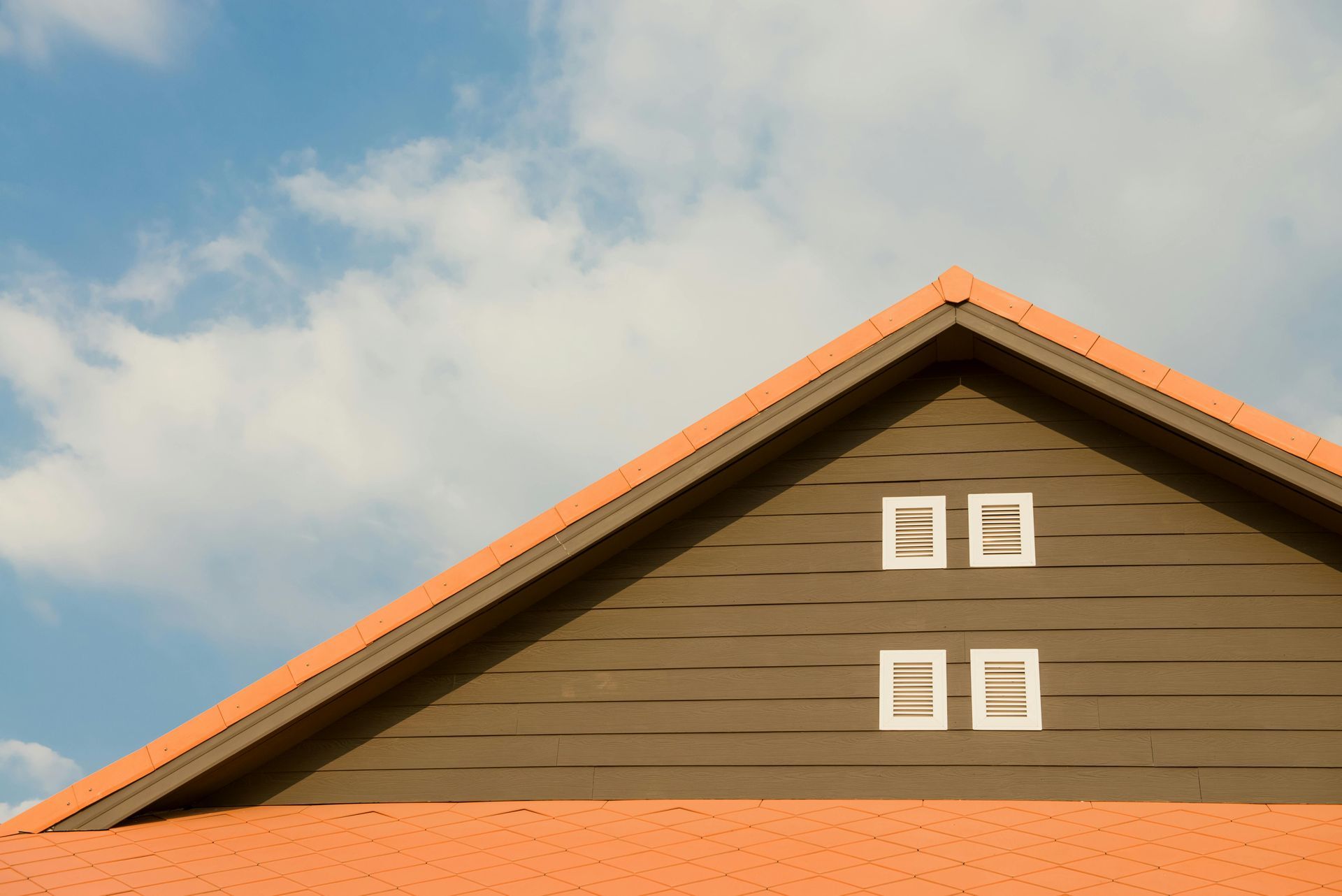Get a free Quote
Contact Us

As a homeowner in Round Rock, Texas, you understand that your roof is your home's first line of defense against our unique Central Texas weather conditions. Between scorching summer heat, occasional hailstorms, and heavy spring rains, your roof endures quite a bit throughout the year. At Up On A Roof Roofing Co., we've served Round Rock residents for years, and we've compiled this guide to help you identify when it might be time for a roof replacement. 1. Your Roof is Approaching the 20-Year Mark Most asphalt shingle roofs—the most common roofing material in Round Rock—have a lifespan of 20-25 years. If your roof is approaching this age or has surpassed it, it's wise to start considering a replacement, even if there are no obvious signs of damage. With our Texas heat, roofs tend to age faster than in milder climates. 2. Curling or Buckling Shingles Take a look at the slopes of your roof that receive direct sunlight. If you notice the shingles are curling or buckling, this is a sure sign that they're past their prime. This type of damage allows water to seep underneath during our heavy Texas thunderstorms, potentially causing extensive damage to your home's interior. 3. Missing Shingles or Granules After a strong wind or hailstorm (which we're no strangers to in Williamson County), check if any shingles have blown off your roof. Additionally, if you find a large amount of granules in your gutters when cleaning them, it indicates your shingles are deteriorating. These granules protect your roof from UV rays, and without them, your roof becomes more vulnerable to our intense Texas sun. 4. Daylight Through the Roof Boards Here's a simple check you can do from inside your house: go up to your attic on a bright day and see if any daylight is coming through the roof boards. If light can get in, so can rain, cold air, and pests. This is a serious issue that needs immediate attention, especially before our next big Round Rock rainstorm. 5. Sagging Roof Deck A sagging roof is a critical warning sign that requires immediate professional attention. It could indicate structural issues, often caused by long-term water damage. With Central Texas's occasional heavy downpours, trapped moisture can gradually weaken your roof's structure over time. Trust Round Rock's Local Roofing Experts At Up On A Roof Roofing Co., we understand the specific challenges that Round Rock homes face when it comes to roofing. Our team of local experts can provide a thorough roof inspection to determine if your roof needs repairs or a complete replacement. Don't wait until a small problem becomes a major expense. If you've noticed any of these warning signs, contact us today for a free consultation. We pride ourselves on honest assessments and quality workmanship that stands up to the Texas elements. Visit www.uponaroof.com or call us to schedule your free roof inspection. We're proud to serve our Round Rock neighbors with integrity and expertise!
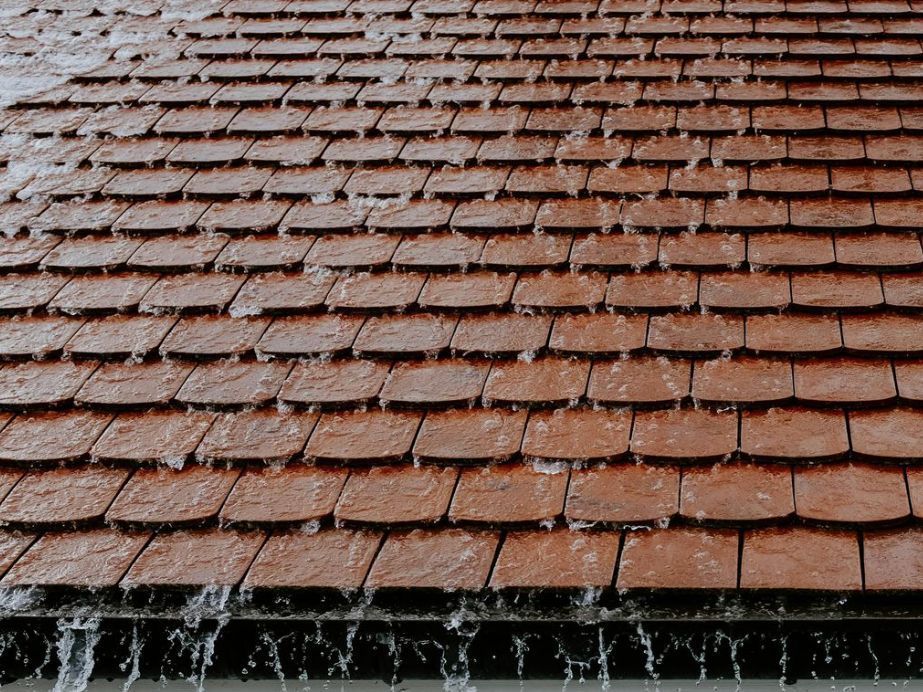
Has your Austin home's roof been damaged by hail, high winds, or other severe weather? You might qualify for a complete roof replacement through your homeowner's insurance. Many homeowners have never filed a claim or feel overwhelmed by the complex insurance process. As one of Austin's most trusted roofing companies, Up On A Roof is here to guide you through every step of the journey. Understanding Storm Damage Insurance Claims Insurance claims for roof damage can seem intimidating, but with the right guidance, the process becomes manageable. Most homeowner's insurance policies cover sudden, accidental damage from weather events like hailstorms or wind damage. However, navigating the claims process requires knowledge and careful attention to detail. The 5-Step Process for a Successful Roof Insurance Claim Step 1: Choose Your Roofing Contractor First This is perhaps the most crucial step that many homeowners overlook. Always select a reputable roofing contractor before filing an insurance claim. Here's why: A professional contractor can thoroughly inspect your roof to confirm you have sufficient damage to warrant a claim Many claims are denied due to "insufficient damage" when homeowners file without a professional assessment Your chosen contractor can document the damage properly with photos and measurements They can identify the specific date of the storm event that caused the damage Pro Tip: Having a roof inspection before filing can prevent wasted time and the possibility of a claim denial affecting your insurance history. Step 2: File Your Insurance Claim Once your professional roofing inspection confirms legitimate storm damage, it's time to contact your insurance company: Call your insurance provider's claims department to initiate the process They'll ask for a "date of loss" (the specific date the storm occurred) Your roofing contractor can provide the exact date if you're unsure The insurance company will assign an adjuster to your claim The adjuster will contact you within 24-48 hours to schedule an inspection Important: Request and record your claim number, the adjuster's name, and direct contact information for easier follow-up communication. Step 3: Ensure Your Contractor Meets the Insurance Adjuster This step is vital to ensure your interests are properly represented: Notify your roofing contractor immediately about the scheduled adjuster visit Having your contractor present during the insurance inspection ensures: All damage is properly identified and documented Technical roofing questions can be answered on the spot Someone with expertise is advocating for you Potential disagreements about damage can be addressed immediately Key Benefit: Your contractor can point out damage that the adjuster might miss, increasing the likelihood of claim approval. Step 4: Review Your Summary of Damage Within 5-7 business days after the inspection, your insurance carrier will provide a detailed report: This document (often called a "scope of loss") outlines all damage found It contains your contact information and property measurements Most importantly, it details all the benefits allocated for your claim Review this document carefully with your roofing contractor to ensure it covers all the necessary repairs Critical Check: Verify that all damaged areas have been included and that the allocated funds are sufficient for quality repairs. Step 5: Understanding the Payment Process Insurance companies typically release funds in two separate payments: Actual Cash Value (ACV) Payment: The first check covers the current value of your damaged roof minus your deductible and depreciation Recoverable Depreciation: The second payment is released after repairs are completed and you provide proof (usually an invoice from your contractor) You'll need to pay your deductible directly to your contractor Important Note: Depreciation is only released if you actually complete the repairs. If you don't use all the proceeds to restore your property, you won't receive the depreciation payment. Why Choose Up On A Roof for Your Storm Damage Repairs With decades of experience helping Austin homeowners navigate insurance claims, our team understands how to make the process as smooth as possible: We provide thorough, honest roof inspections before you file a claim Our team has extensive experience working with all major insurance companies We document all damage comprehensively with photos and detailed reports Our representatives can attend your insurance adjustment to ensure fair assessment We handle all paperwork required for your depreciation release Our work is backed by industry-leading warranties Take Action: Schedule Your FREE Storm Damage Roof Inspection If your Austin area home has recently experienced severe weather, don't wait to have your roof inspected. Even minor damage can worsen over time, leading to more extensive and costly repairs. Up On A Roof offers comprehensive storm damage assessments with no obligation. Our experienced team will provide honest feedback about your roof's condition and guide you through your options, whether that involves an insurance claim or simple repairs. Contact us today to protect your home and your peace of mind.
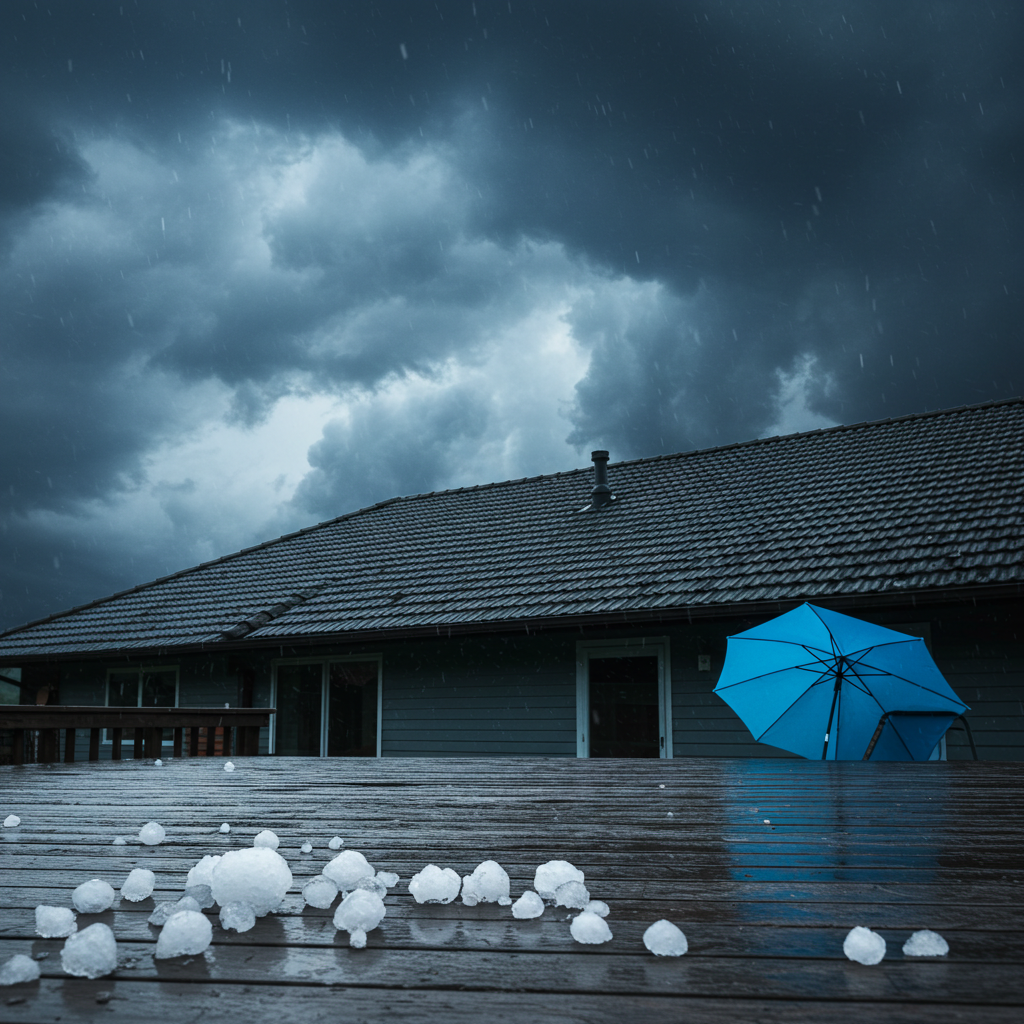
As your local roofing experts at Up On A Roof, we've prepared this helpful guide to assist homeowners in protecting their property during hail season. Understanding Hail and Its Potential Effects Hail develops when storm updrafts carry raindrops to freezing altitudes where they collect ice layers before falling. These ice formations can impact your home and may affect roofing, gutters, windows, and siding. Our region experiences hail events throughout the year, particularly during spring and early summer. Even smaller hailstones can affect your roof's integrity when combined with strong winds. Recommended Preparations for Hail Events Vehicle Protection Options: When possible, park vehicles inside garages or under covered parking areas If covered parking isn't available, you might consider using blankets for additional protection Choose parking spots away from trees and power lines if garage space isn't an option Securing Outdoor Items: Consider bringing patio furniture, grills, and decorations inside Secure larger outdoor items that cannot be moved indoors Remember to collect any packages, mail, or deliveries from exposed areas Relocate potted plants to more sheltered locations if feasible Home Preparation Suggestions: Close and secure all windows and doors Draw blinds or curtains as an extra precaution for windows Check that gutters and downspouts are clear for proper storm water drainage If you have outdoor umbrellas, closing and securing them is advisable Family Comfort and Safety: Plan to keep pets indoors in comfortable spaces Identify interior rooms for family gathering during the heaviest weather Keep mobile devices charged for weather updates and communication Have flashlights available in case of power interruptions During Hail: Recommended Actions When hail begins falling: Remain indoors away from windows until the weather improves Resist the temptation to watch the storm through windows, as this can be hazardous if hail is large or winds are strong Keep children and pets in interior rooms for their comfort and safety Monitor local weather updates for information about storm duration and intensity If driving is necessary during hail, consider pulling over to a safe, covered location until conditions improve After Hail Subsides: Assessing Your Property Once the storm has passed and it's safe to go outdoors: Initial Safety Considerations: If the storm occurs after dark, wait until daylight for thorough exterior inspections Be aware of your surroundings and watch for downed branches or power lines Use caution on wet or slippery surfaces when checking your property Helpful Documentation Steps: Take dated photographs of any visible effects for your records Note the date, time, and approximate duration of the storm Document any obvious signs of impact to your property What to Look For Around Your Home: Check for dents in metal gutters, downspouts, or vents Look for displaced shingles or roofing materials Note any granules (small dark particles) collected where water exits downspouts Inspect window screens, siding, and trim for possible damage Check for water spots on interior ceilings or walls How Up On A Roof Can Help Homeowners Our experienced team understands regional weather patterns and how they affect local homes. We offer: Professional Roof Assessments: After hail events, we provide thorough roof evaluations to identify any issues that might not be visible from ground level. We check for subtle indicators that could affect your roof's performance and longevity. Helpful Documentation: If we find storm-related concerns, we provide clear documentation that can be valuable for your records and insurance purposes. Guidance Through Insurance Processes: Having worked with many homeowners, we understand insurance claim procedures for weather-related situations and can offer helpful guidance. Quality Repair Options: When repairs are needed, we provide reliable solutions with quality materials appropriate for our climate conditions. If you have questions about how hail might affect your home, or if you'd like to schedule a roof check after a storm, please contact us at 737-788-ROOF (7663). Wishing you safety and comfort during severe weather events, The Up On A Roof Team 1 Chisholm Trail Rd #450, Round Rock, TX 78681 Business Hours: Mon-Fri 8:00 am - 8:00 pm, Sat 12:00 pm - 5:00 pm, Sun 2:00 pm - 6:00 pm
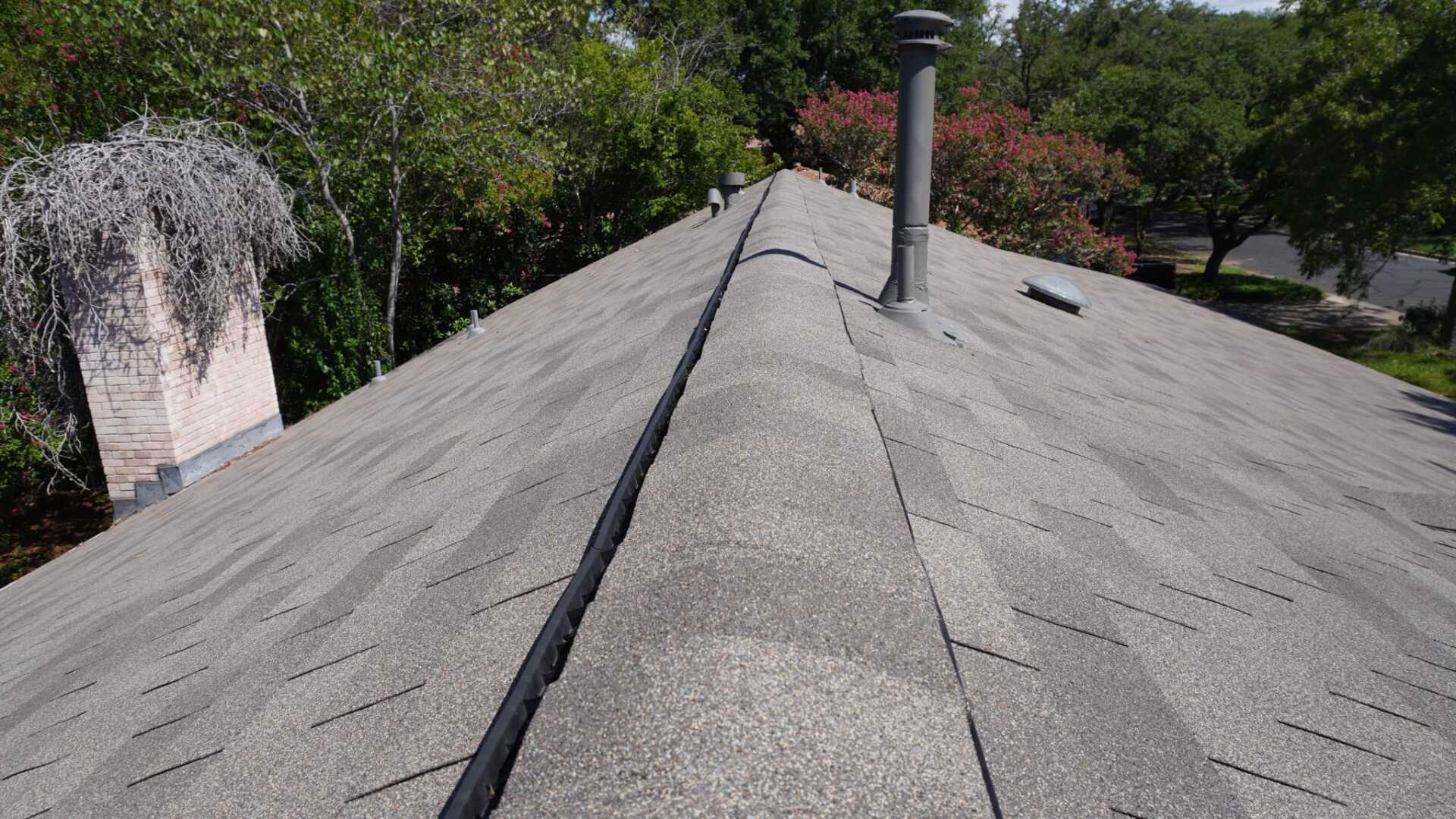
Roof ventilation is an important component of maintaining a durable roof. Without proper ventilation, a roof can be damaged by many elements such as moisture buildup, heat, and other environmental factors. In this blog post, we will explore the importance of roof ventilation, the different types of roof ventilation systems, and how to properly maintain your roof ventilation system. The Importance of Roof Ventilation in Austin Roof ventilation is important for many reasons. The purpose of roof ventilation is to remove excess heat and moisture from the attic and roof space. This can help to prevent damage to the roof and the structure of the home. When heat and moisture build up in the attic, it can cause the shingles to deteriorate, the wood to rot, and mold to grow. It also increases your cooling demand. This can lead to costly repairs and replacements. Another important benefit of roof ventilation is that it can help to increase the lifespan of the roof. When the attic is properly ventilated, it can help to prevent the shingles from overheating, which can cause them to become brittle and break down more easily. In addition to that, proper ventilation can help to prevent ice dams from forming during the winter, which can cause water to seep into the attic and cause damage to the roof and the structure of the home. Types of Roof Ventilation Systems There are two main types of roof ventilation systems: passive and active. Passive ventilation systems rely on natural airflow to ventilate the attic, while active ventilation systems use mechanical devices like fans or turbines, to move the hot air. Passive ventilation systems typically include soffit vents and ridge vents. Soffit vents are located in the soffit, or the underside of the eaves, and allow air to enter the attic. Ridge vents are located at the peak of the roof and allow hot air to escape the attic. Active ventilation system typically include power vents and attic fans. Power vents are mechanical devices that are installed in the attic and use electricity to move the air. Attic fans are also mechanical devices that are installed in the attic and use electricity to move the air. They are typically used in conjunction with passive ventilation systems to increase the airflow in the attic. How to Properly Maintain Your Austin Roof Ventilation System To properly maintain your roof ventilation system, it is important to regularly check for any signs of damage or blockages. This includes checking for any holes or cracks in the vents, as well as checking for any debris that may have accumulated in the vents. If you find any damage or blockages, contact a local roofing company near you or any reputable roofers in Austin. Another important aspect of maintaining your roof ventilation system is to ensure that the attic is properly insulated. Insulation helps to keep the attic cool in the summer and warm in the winter, which can help to prevent the formation of ice dams. Additionally, it is important to keep the attic clean. In conclusion , roof ventilation is an essential component of maintaining a healthy and durable roof. Without proper ventilation, a roof can be damaged by moisture buildup, heat, and other environmental factors. There are two main types of roof ventilation systems, passive and active, and it's important to properly maintain them by regularly checking for any damage or blockages, repairing them when necessary, and ensuring that the attic is properly insulated. Please don't hesitate to contact an Austin roofer if you have any questions on this subject.
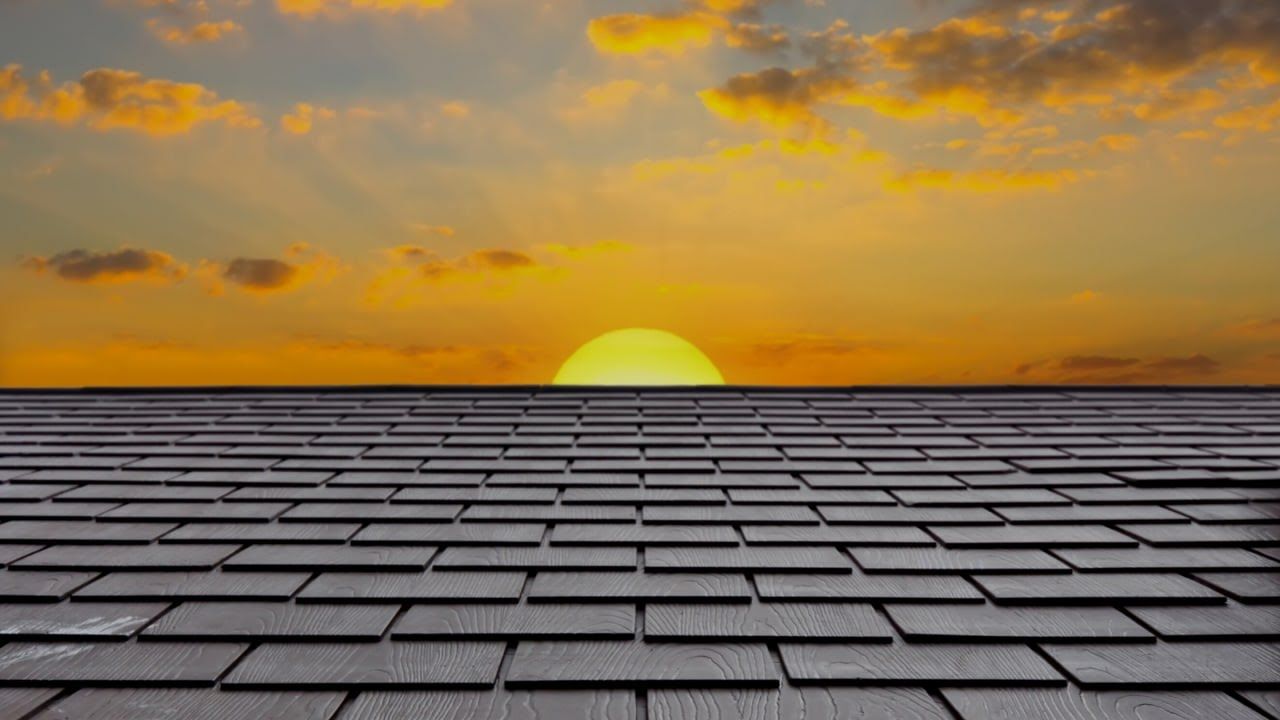
Winter has arrived in Austin, and with winter comes humidity levels. As the cold, moisture-laden air from outside finds its way into your home through cracks, drafty doors, and windows, it can clash with the warmer air indoors and condense on surfaces, leading to damage to your roof. This is why it is important to take preventative measures to protect your roof from humidity. One way to prevent indoor humidity is to check for signs of mold growth on the surface of your roof. If you find any, make sure to get your roof inspected by an Austin roofing contractor. Another way to prevent indoor humidity is by using a hygrometer to track the humidity levels in your home. Ideally, humidity levels should be between 20% and 50%. Proper attic and roof ventilation is also crucial in preventing damage to your roof. The right amount of ventilation can help prevent premature wear on shingles and other components of your Austin roof, such as flashing, rafters, and insulation. It also helps to prevent excessive moisture buildup, which could lead to mold growth due to the high humidity levels indoors. It's also a good idea to check for damage that may have occurred during the summer. One way to prevent outdoor humidity damage is to examine the flashing around vents, chimneys, and other openings in your roof for rust or corrosion. If you find any rust or corrosion, contact us at Up On A Roof Roofing Company , Austin's premier roofing company. In Summary, indoor and outdoor humidity can have a major impact on your roof during the winter, resulting in significant cost in roof repairs and replacements . Stay vigilant and call an Austin roofer if you have any questions.
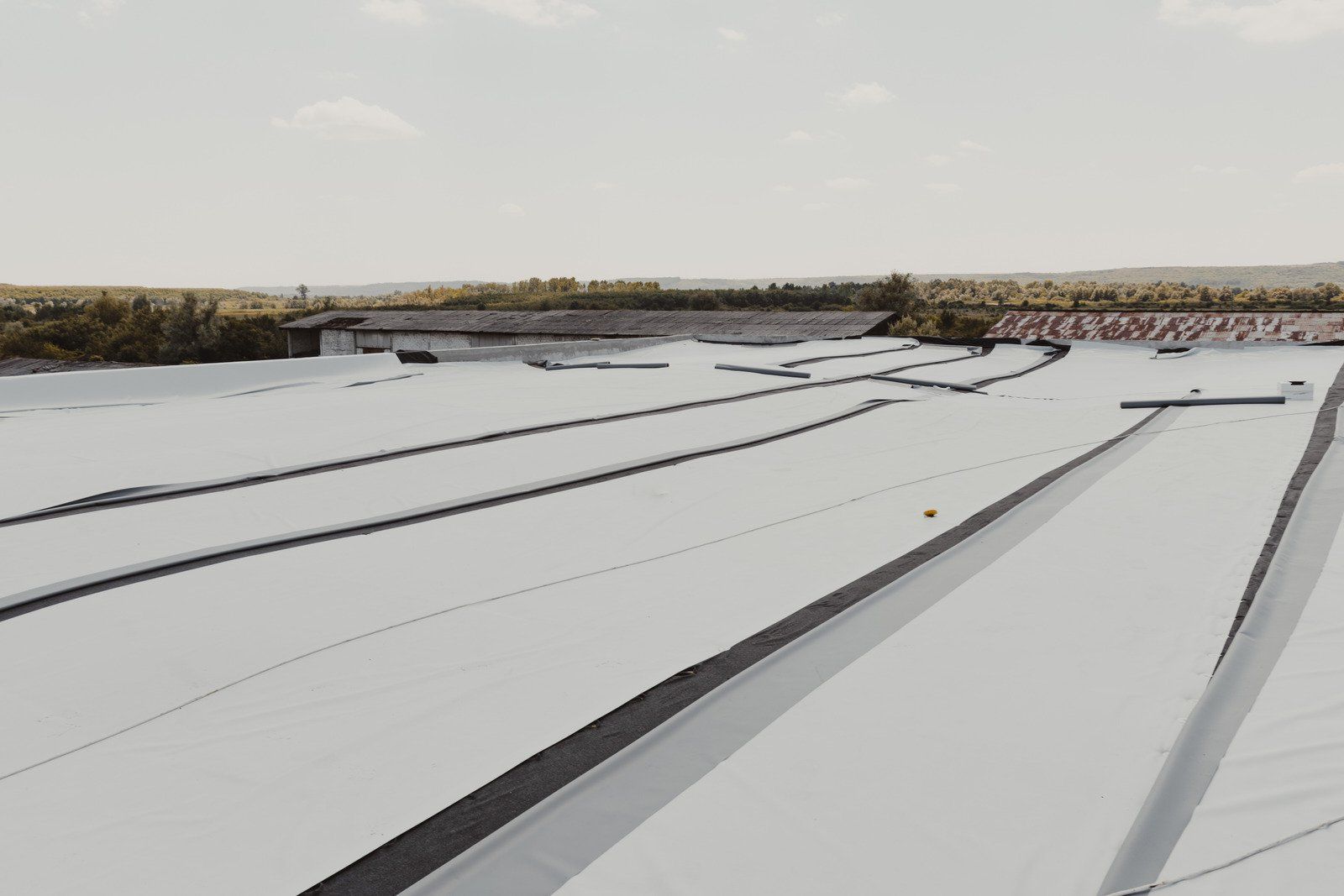
Roof coating is a protective layer that is applied on the roof surface to protect it against the elements and extend the life span of the roof. Coating might be an easier and more cost effective solution for some individuals. At Uponaroof, we have helped many of our clients through this method. Sometimes the cost of replacing a roof is much higher than anticipated. This is true especially in the case of commercial buildings. A flat roof on a commercial building can disrupt business and even shut down the entire operation for a few days in order to be replaced. Coating on the other hand could be a much better option in these situations. In some cases, coating can reduce the entire temperature of the building due to its resistance to UV rays (depending on the product and the color) lowering your overall power consumption. According to our studies, coating can reduce the building's cooling demand by 10_15%, that'll help maintain the HVAC system in a much better condition. Roof Coating Qualifications Although coating might be a perfect solution for some individuals, not everybody qualifies. You can call an Austin roofing contractor to see if your roof is a good candidate for coating. The following is the list of roofs that can qualify to be coated: Roofs with less than 20% wet substrates Roofs lacking surface protection due to years of exposure (granule loss, wear and tear) Cracked or splitting roofs with little to no leak history Old metal roofs with fasteners backing out Roofs that are no longer under warranty Here are a few examples of roofs that don't qualify: Roofs with a history of water penetration Rusted through metal roofs Roofs with membranes eroded past scrim Coating Application Coating a roof is a skill just like anything else. We highly recommend you reach out to a professional Austin roofing contractor for installations. Here is a simple example of how to apply coating on a roof. This is regarding one of our favourite coating products, Karnak. sweep and power wash the roof surface in order to remove any foreign elements such as rust, minerals, algae, etc. Seal the seam and penetrations per manufacturer's guidelines Apply the base coat (primer) Apply the finish coat Overall, coating might be a great option to extend the lifespan of your roof, reduce the cooling demand and improve the visual appeal of your roof. However, before making a decision be sure to weigh the pros and cons and see if your roof qualifies for a coating application.

One of the most common elements that can severely damage your roof is hail. Hail can fall down at a speed of 25_40 mph during a typical thunderstorm but larger hailstones can reach a terminal velocity of 44-72 mph. According to NOAA larger hailstones can fall even at 100 mph. 2 inch hailstones are enough to damage your roof and your car, 4+ inch hailstones not only can damage your properties but cause serious physical injury to humans and livestock. How to protect your property against a hailstorm? Park your car in the garage if possible. If you have a garage, park your vehicle inside to protect it from hail damage. If you don't have a garage, try to find a covered area. Use window covers. If you have windows that are exposed to hail, consider covering them with storm shutters or plywood. Do not leave any belongings outside. Pots, glass tables, plants or anything fragile should be moved inside as soon as a thunderstorm is forecasted. Seek shelter. If you are caught in a hailstorm be sure to seek refuge as hail can cause serious injuries. Call an Austin roofer and get your roof inspected immediately. Be sure to have your roof inspected and have your contractor walk you through the claim process. Most insurance companies do not pay completely for roofs with old storm damage so If your roof has been damaged by hail, file a claim immediately. How does hail damage your roof? Hail displaces the granules on your shingle roof and breaks the matting. Once matting is broken, water can slowly seep through causing rotten decking, mold and eventually leaks if neglected. Hail can severely reduce the lifespan of your roof. Even small hail can loosen the granules making them easier to get washed away by future weather events. Many people believe their roof is in perfect condition after a hailstorm because they do not see any damage from the ground. This is a common misconception amongst homeowners. Hail damage is not easily identified and especially from the ground. We recommend you to get your roof inspected by a roofing contractor in Austin to get a professional opinion. Conclusion Hail damage can be problematic for homeowners. Please take protective measures to protect yourself and your property in the event of a hail storm. And don't hesitate to seek help. Here at Uponaroof, we take pride in helping our communities. Give us a call at 737-788-7663 . We would love to serve our great fellow Austinites.

How much should my roof cost? When you’re planning a roofing budget, this question keeps on lingering in your mind. You don’t know whether to trust the contractor’s estimate or believe what your neighbor spent on a new roof. If the owner of an attractive house down your street spent $10,000 on a new roof, you’d also wish to spend the same. Thus, you find yourself in confusion when the contractor estimates your cost at $25,000. It is essential to note that roofing contractors consider several variables to arrive at an accurate estimate. Different homeowners also have varying roofing needs depending on house designs, aesthetic preferences, weather, and budget. How do these factors affect the overall roofing budget? Here is everything you need to understand about roofing costs. The Size of the House Your house’s size is the first variable that determines the cost of installing a new roof. A two-bedroom house will not attract the exact roof replacement costs compared to a five-bedroom house. When calculating the size of your roof, don’t forget to include the garage. The size of your garage also affects the total cost. Thus, you can live alongside another homeowner in the same street, but he still spends much on roofing then you. A bigger house will require more roofing materials than a smaller house. Moreover, your contractor will likely recommend high-quality materials since the entire roofing structure will slightly be heavy. For instance, you’ll need three bundles of biomaterial for every ten by ten-foot area. As for shingles, a bunch will only cover one square for three bundles. Modern shingles cost about 150 bucks. If you do the math, the cost can be relatively high for big houses. Roofing Structure Design The structure and height of your roof will affect the overall costs of installation in many ways. First, a complicated roof will take a more extended period to install than a simple roof structure. The more time the roofing company spends on your roof, the more you’ll likely pay. If you have an older roof, it will need great precaution to remove the structure's rotten parts. This slows down the installation process; hence it can go longer than expected. In that case, expect to part with some good amount of money. A roof that is two or three stories high will present many difficulties during installation; hence it can also slow down the process. Other factors that affect completion time include the surrounding structures such as trees and landscape. You paid a lot of money to install a landscape design, and the last thing you want is objects falling on them. Thus, it may force your contractor to be extra precautious during the installation. That includes covering the landscape to trap the falling debris and dump them somewhere else. Labor Intensity As noted, the design of your roof structure can slow down roofing technicians. In some cases, it can force them to put in extra work then they do in standard installations. Take an example of a steep roof. It will need at least two technicians to install shingles. While one guy is hanging on a rope to drive in the shingles with a nail gun, the other is feeding him the materials. Working in such a position is quite tiresome and risky. In that case, the contractor would want more pay for the labor services. Storied roofs also present the same challenges. Some workers remain on the ground to supply the materials to the guys on top. Heavy materials are the hardest to handle and may even require a particular machine to move them to the top. Conversely, a lower roof is the most affordable to install. Besides attracting a smaller number of technicians, the installation will also be complete within a short span. Material Cost Material cost will vary depending on the type of roof, lifespan, aesthetic preferences, and weather conditions. Homeowners in Texas might want to protect their roofing tiles from direct solar intensity during hot summers and heavy rains in spring. In that case, you’ll need coating materials like sand granules to enhance the lifespan of the roofing tiles. In the case of aesthetic preferences, they’ll vary from one homeowner to another. You’ll pay more for customized roofing materials compared to standard. Roofing materials with lifespans exceeding 30 years will cost more than ordinary materials. However, they’ll serve you well, attracting minor repair and maintenance costs. You may prefer parting with less money today, but that could mean umpteen repairs in the future. Thus, go with the materials that reflect your money’s actual value. Get in touch with experienced roofing contractors like Up On a Roof Roofing Company who can access a great variety of materials at wholesale price. That way, you’ll have many options that fit within your budget. Remember, you don’t have to spend extravagantly on roofing materials if it’s not within your economic means. The industry has all types of materials ranging from the least to the most expensive. The choice is yours. Roofing Contractor All the variables may influence affordable roofing costs, but your most preferred contractor chooses to shortchange you. You’d want to deal with a trustworthy and transparent Austin roof company that doesn’t inflate estimates to cater to their greed. In that case, approaching a company with years of experience in the industry sounds like the best plan. Such a company already has many clients and can hardly keep up with the ever-growing demand for their services. They are not trying to generate a new business like budding companies. Contractors with over two decades of experience will give you honest opinions about your roof to conclude an accurate estimate. For instance, a contractor should take actual measurements of the structure instead of estimating from afar. That could end up buying excess materials that will either go to waste or another client’s roofing project. You can determine the roof’s actual size from an eagle view and how much each square foot should cost. Your contractor should also be in a position to give an accurate quote of the additional materials. Before getting into a contract with any Austin roof company, do preliminary research to find someone you can count on for a budget-friendly replacement. Ensure that the contractor explains all the variables considered to arrive at an estimate, lest you get charged more than necessary. Roof and Attic Ventilation Do you have any ventilations in the current structure? If no, your contractor may want to resolve the issue before installing another one. Poor ventilation causes condensation in the inner parts of the roof. A moist attic will result in mold infestation and rusting of metallic parts of the roof. This reduces the material’s lifespan, and more repairs will likely follow sooner than you know it. Established contractors only want to revisit your home if you welcome them to dinner and not a falling roof. That will downplay their reputation. Your roofing contractor will charge additional repair costs for damaged ventilations. Damages associated with vents include: Missing gable vents Inadequate rafter vents Blocked cut through in the roof peak If your roof doesn’t have attic ventilation, the contractor may use various materials that will affect the overall replacement cost. Location Your location will affect the costs of roof replacement in three main ways. Besides mitigating the climate factor by material choice, varying market forces may affect cost fluctuations in different areas. In most cases, the costs of installing a roof in an urban setting will be different compared to a rural one. However, the price variation is slight as high-quality roofing materials will still attract nearly the exact costs, regardless of varying living costs in each region. The contractor may have to adjust the labor charges and profit margin. If your location is far from the contractor, the company may forgo free delivery services as it dramatically impacts their profit margin for that particular contract. Your roofing estimate won’t be the same as someone living near the company and can enjoy free delivery services. Transportation costs will depend on the distance, the number of trips, and the type of materials. Fragile roofing materials like clay tiles may be relatively costly to transport. Moreover, it is essential to note that most Austin roofing companies prefer serving specific areas to mitigate the high costs of working in distant locations. If you agree to a long-distance estimate, including extra storage space for their materials, they’ll come. There Can Be Unforeseen Costs Many Austin roofing companies will endeavor to give you the most accurate estimate for roof replacement. Even so, some hidden costs may bypass the inspection but manifest during the installation process. For instance, checking the attic can be quite challenging due to insulation and vaulted ceilings. Inasmuch as you want a new roof, you wouldn’t appreciate the contractor damaging the old one during inspection before the new one is ready for installation. It is advisable to always include some spare cash in your budget to take care of matters that may arise. Addressing the hidden costs as soon as they arise will expedite the installation process to save you time and money. About 20% of the total estimate in extra cash would suffice. Necessary Insurances Another variable that homeowners mostly underrate is the insurance cost. Depending on your state and a company’s policy, the contractor may need various insurances to complete the job legally. For instance, there might be liability insurance, workers’ comp insurance, and disability insurance. These insurances cover the workers operating in your yard to shield you from being liable for any unfortunate accidents. Severe work accidents are minimal, but it helps if the roofing company is always ready for anything. The more insurances a contractor subscribes to, the more the roof installation cost to cover operation costs. Moreover, the roofing industry's insurance rates are pretty high compared to others because of the many risks involved. Other hidden fees that your contractor will consider include municipality fees and permit costs. While most municipalities will charge a flat rate fee, permit costs may be higher depending on the entire job's contracted amount. Even so, footing these costs should be the contractor’s responsibility. Be wary of contractors who tell you to facilitate various permits. Such contractors are trying to save money on their side, and you may still find the amounts reflecting in the estimate. Conditions of the Structure Lastly, the conditions of the underlying structure will significantly influence your roof cost. In most cases, you’ll install a new roof if you’re either constructing a new home or replacing an old one. In the case of new homes, the structure will be new; hence the estimate will remain constant. For older homes, the structure may be weak, rotten, or damaged. Factors that affect the lifespan of your underlying roof structure include water damages and debris accumulation. During winters, you can also experience snow and ice dams. A reputable roofing contractor will not install the new roof unless the underlying structure is in good condition. In the case of a rotten frame, you’ll need a replacement. Some experts can also install a rafter to support a weak frame. These minor repairs and fixtures will affect the overall cost of installing a new roof. You might also need to clear accumulated waste materials in the roofing layers. The more waste on your roof, the higher the dump costs. Before installing a new roof, do an inspection to determine whether the underlying structure is in a suitable condition. If you need repairs, ask for a separate structural estimate to track your expenses. You don’t want someone to charge you expensively because they see an opportunity to ask for more cash. Wrapping It UP These variables help determine how high or low your roofing costs could be. Other additional charges will depend on your accessories and add ons to enhance aesthetic appeal or the roof’s lifespan. For instance, you can go for custom flashing, gutter covers, or even skylights. Anything that is outside the scope of a standard roof installation will affect the overall cost. Don’t forget that your contractor’s experience matters a lot. Talk to experts at Up On a Roof Roofing Company who pride their services on transparency and accuracy regarding roofing estimates. Contacting Our Business and Scheduling a Free Consultation Our company provides commercial roofs that feature high-quality materials, and our business can also repair many types of roofs, offer 24/7 services and provide free estimates.
